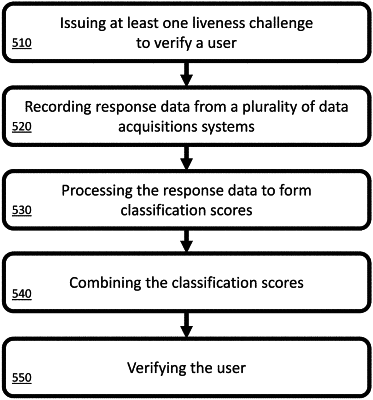| CPC G06F 21/32 (2013.01) [G06F 17/16 (2013.01); G06K 9/6267 (2013.01); G06T 7/70 (2017.01); G06V 40/45 (2022.01)] | 11 Claims |

|
1. A computer-implemented method for verifying an electronic device user, the method comprising the steps of:
issuing at least one action instruction comprising a liveness challenge to an electronic device user using a notification mechanism of the electronic device;
recording response data from a plurality of data acquisition systems of the electronic device, the response data pertaining to the user's response to the at least one action instruction;
processing the response data to form classification scores, including identifying, from the response data, the likelihood of at least one characteristic pattern associated with an action instruction, comprising:
processing video data to assess a classification score of at least one characteristic motion associated with the action instruction by:
performing a plurality of head pose estimations on the video data,
processing the plurality of head pose estimations to form extracted pose information, including: extracting a series of angles from the plurality of head pose estimations; fitting a function to the series of angles; constructing a feature vector from parameters of the function, the fitting of the function, and the head pose estimations; and testing if the video data contains at least one characteristic motion with the feature vector, and
forming a facial action classification score using the extracted pose information;
combining the classification scores to form a classification value; and
verifying the user when the classification value satisfies a threshold.
|